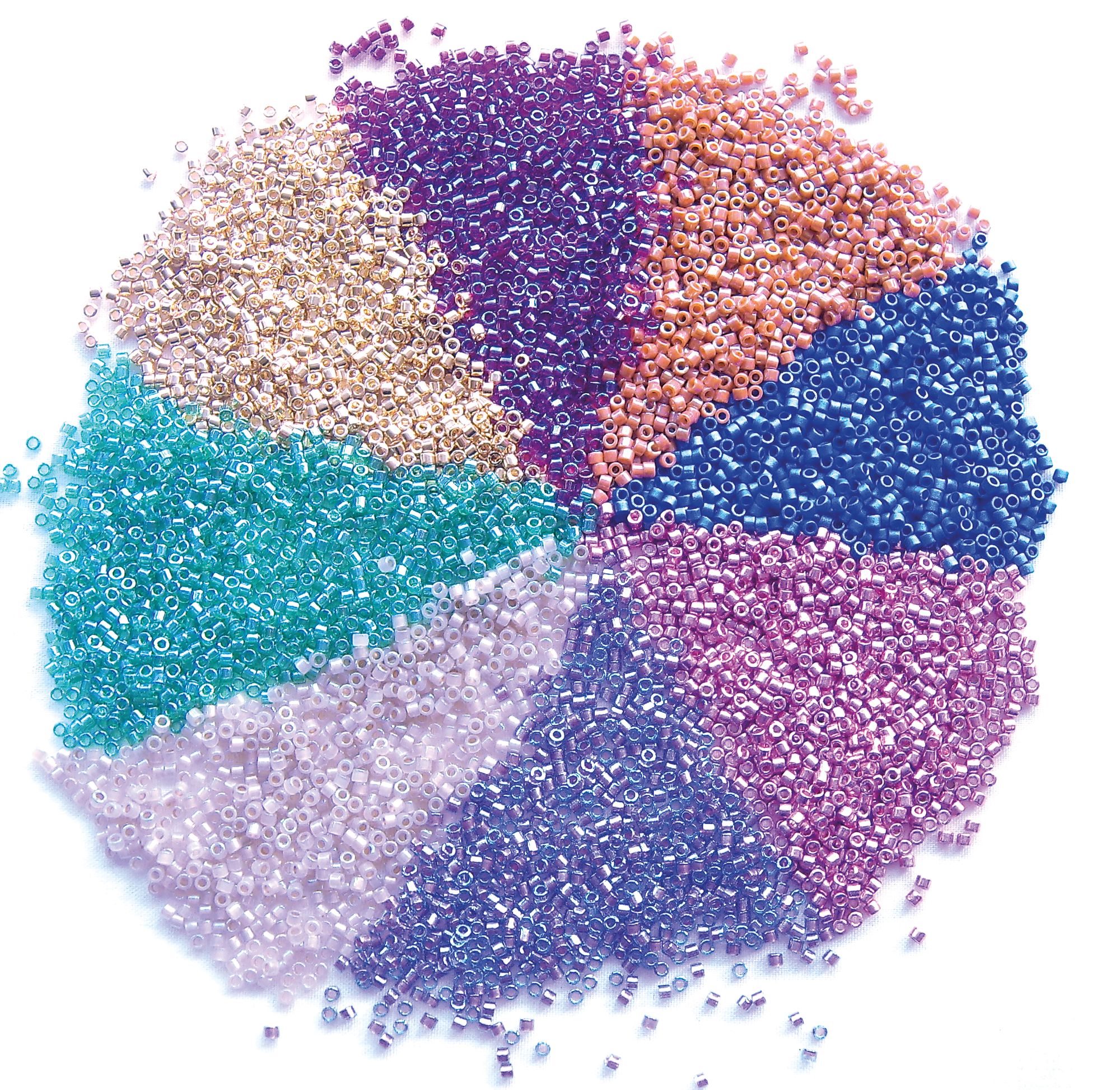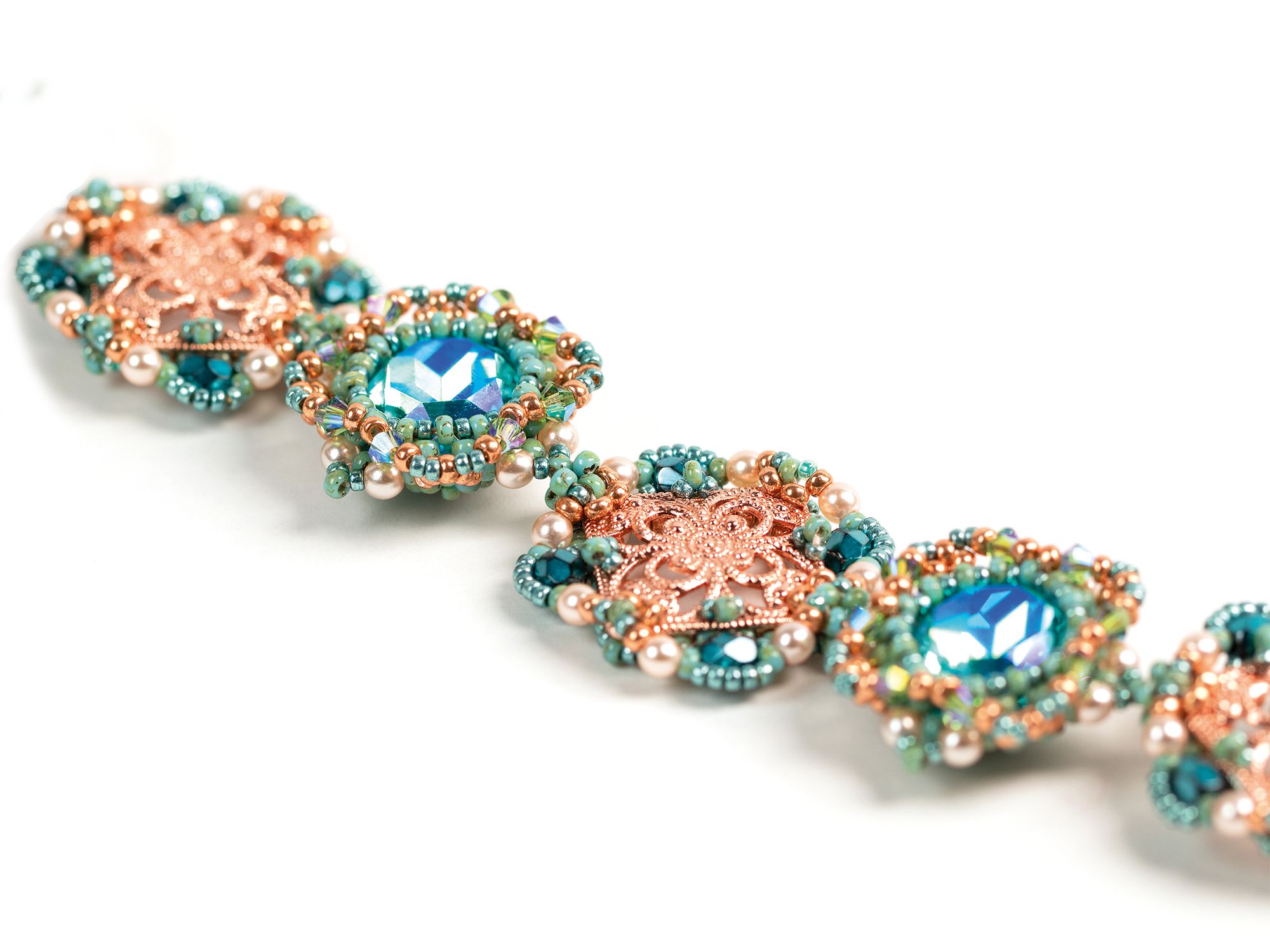Colour is such an important element of design . It is not uncommon for someone in a two-hour class to spend the first half-an-hour just debating the colour of the beads they use. It can literally make or break a project. The problem is that colour is also such a personal thing. We all respond to colour in different ways and what appeals to one person may appear hideous to another. If you see a project, but do not like the colouring, it can be difficult to look beyond that and appreciate the structure and pattern formed by the beads. This is the reason that professional designers often make the same project in several different colour schemes, so that when they sell the tutorial, they can demonstrate how it will look across a range
of colouring and hopefully appeal to more people. Plus, as a designer, it’s always interesting to see how your project works differently!

It is also a fact that some people have a natural flair for colour and others are simply afraid of it. For all of us, it is easy to get stuck in a colour rut. It takes courage to branch out from the colours you know and love, or perhaps to try a colouring that is different from the one used by the designer of the tutorial. So, if you want to become a bit more confident with colour choices, what can you do about it? Here's a few practical tips to try out, and see if they help!
Stuck in a colour rut
How do you know that you’re stuck in a colour rut? Well, a big clue is to take out all the jewellery you've made in the past six months and lay it out together. Does it all use the same kind of colour scheme? If the answer is ‘yes’, then you may be stuck in a colour rut. Before we move on to tell you what you can do about it, just remember you may not need to do anything. If you are happy working with those colours, then keep doing it. If all the clothes in your wardrobe are in the same colouring, then maybe there is also a practical reason for keeping to these colour schemes. Or maybe you feel it is time for a change.

So, the first thing we suggest is that you take ‘baby steps’. Change is scary and if you change too much all in one go, you may even find you hate it simply because it is just too different to your comfort zone. In addition to that, it may not be practical to buy an entirely new bead stash. So, start by changing one small thing. If you normally use turquoise and often work in a very analogous colour scheme, then try keeping the turquoise, but adding in a complementary colour – say gold. You still have something familiar, but that familiar colour will really work in a new way when it's paired with something very different. When you've become accustomed to that change, make another one. This could be trying your turquoise with a different complementary colour, or adding in a new colour to your first scheme.

A bolder move
If you feel like a complete change, then forget all your old ideas of colour and start afresh. Pick your favourite pattern and work out which is the main bead used in
it. Go and buy a tube of this type of bead in a completely new colour – something that you do not have in your stash at all. Do not be tempted to go out and agonise for hours over this: make it spontaneous. Walk into a bead shop and scan the wall or trays of beads, then pick up the first colour that jumps out at you – as long as it is different to all your existing beads.
Armed with your impulse buy, go home and find beads from your stash that will work with it. We can guarantee you will have some. The chances are, you'll find that trying this new colour with one of your old favourite colours gives a whole new dimension to your work. At worst, neutral colours like black, white or metallic, go with everything!

Experimentation
If you are still feeling a little bit shy about adding something new to your stash, then you can probably find a new scheme from within your existing beads. For your next beading session, carry out an experiment. Take out all your beads
and try making small, easy samples (this could be a little strip of beadwork in your favourite stitch). You need to make the same sample, but in each one, use a differ- ent combination of beads. Again, be a little scientific about this: pick a bead for your main colour, then make a series of samples that each use different beads with that main colour. How does each sample work? What does each ‘new’ colour do to the way your main colour looks? What appeals to you? Remember to make a note of colour combinations that you like, then you can try them in your next project.

One of the reasons that choosing beads can seem so agonising is that the way in which they ‘play’ together can be hard to predict. Firstly, when you see them all together in a tube or bag, the colour you see is likely to be far denser than the way that they will appear when you use them. Secondly, they appear to change according to their surroundings. The science of this reflects the way in which light is reflected from or absorbed into the surface of the bead. In practice, it means that the tone of the beads can appear very different when they are sat next to different beads. I wish I could tell you that there are ways to predict how all of this works, but if there are, then I have yet to discover them. There are plenty of rules around colour theory and plenty of good books that look at colour theory in beading, so if you are interested in learning more about the science behind this, you could try Margie Deeb’s books on colour. However, the best way to find answers is to carry out your own experiments. Through experience you will get better at predicting how different beads might work on their own or in combination with others, but however experienced you are, the beads are still liable to surprise you from time to time!

Observation
If you are still feeling a little nevous about this, then there is nothing wrong with being guided by the experts. Take a look at beading projects and really analyse their colours. Is the overall colour scheme monochromatic, analagous or complementary? How has the designer mixed in different bead finishes? Are the background colours matte or shiny? Are the brightest colours in matte or shiny beads? Are all the colours balanced or did the designer use some in small quantities as highlights? These are all questions that you can ask yourself. You may start to see patterns emerging which will help you to discover what works for you.
One important message: colour is personal. There may be many ‘rules’, but there is no real ‘right’ and ‘wrong’. If you love a colour scheme, then use it and enjoy it, even if the rest of the world hates it. The joy of beading comes from being able to express yourself, so spend some time finding what you love and then enjoy working with it.


